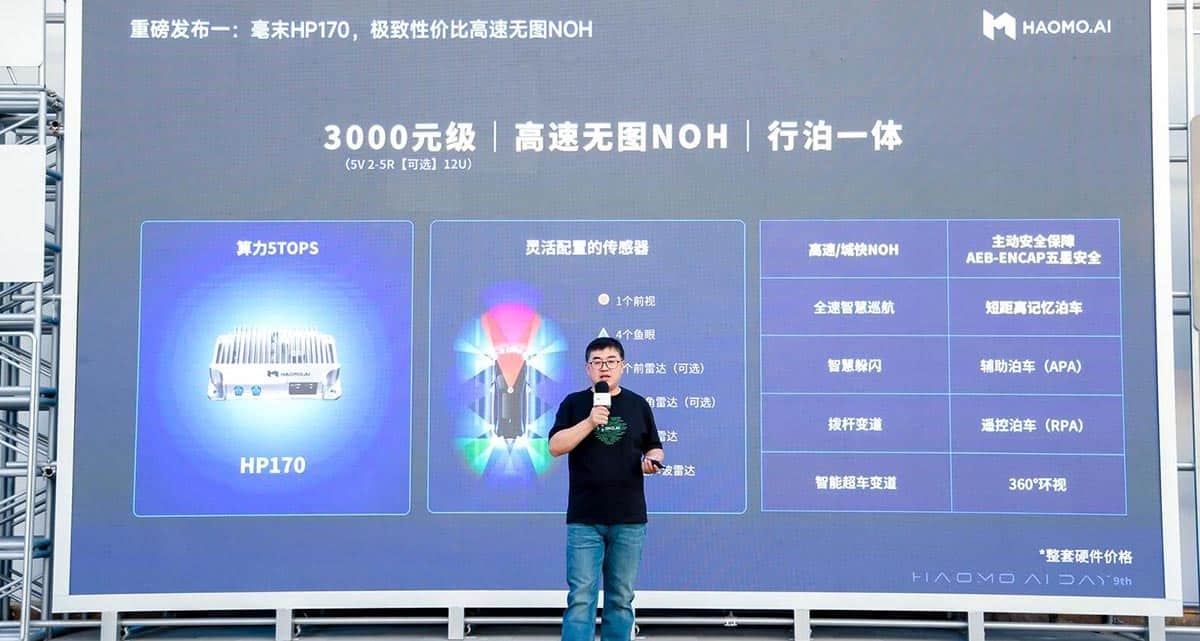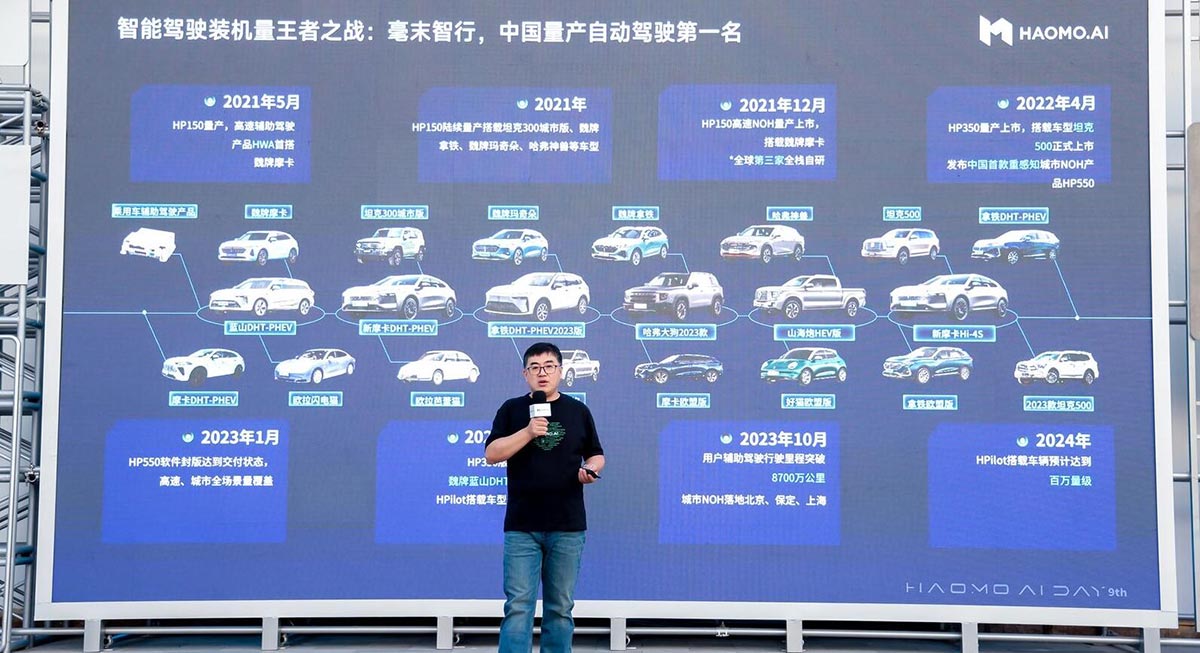Haomo unveiled three ADAS kits priced as low as $410 and not relying on high-definition maps to capitalize on the opportunity presented by smart driving features that will cover the vast majority of new cars over the next two years.
(Haomo chairman Zhang Kai speaks at the October 11 AI Day event. Image credit: Haomo)
Haomo.AI Technology, a Chinese startup backed by Great Wall Motor, has unveiled new Advanced Driver Assistance System (ADAS) kits, and their low costs promises to accelerate the widespread adoption of smart driving features in China.
Haomo unveiled three ADAS kits -- HP170, HP370 and HP570 -- at its 9th AI Day event today, saying they are the industry's lowest-priced driver assistance systems that do not rely on high-definition maps.
The kits are priced as low as RMB 3,000 ($410), and Haomo aims to have them installed in low-end to high-end passenger cars to capitalize on the opportunity presented by the expected 70 percent penetration of smart driving features by 2025.
Lowest cost
These assisted driving kits from Haomo are the lowest priced we've seen to date and promise to accelerate the scaling of smart driving features in the cost-sensitive mass market.
The previous record holder for lowest cost assisted driving kits was Alibaba-backed local self-driving company DeepRoute, which released its Driver 3.0 solution on March 22 with hardware costs as low as $1,000.
Haomo's HP170, priced between RMB 3,000 and RMB 3,999, enables autonomous driving on highways and expressways, automatic emergency braking rated five-star by E-NACP, and short-distance memory parking.
The kit has a computing power of 5 Tops and a sensor system with one forward facing camera, four fisheye cameras, two rear corner radars and 12 ultrasonic radars, and with one forward-facing radar and two front corner radars as optional.
The HP370 is priced from RMB 5,000 to RMB 5,999 and supports more features such as memory driving within the city and intelligent obstacle avoidance.
The kit comes with 32 Tops of computing power, two forward facing cameras, two side-view cameras, one rear-view camera, four fisheye cameras, one front radar, two rear corner radars, 12 ultrasonic radars and two front corner radars as optional.
The HP570 is priced from RMB 8,000 to RMB 8,999 and enables automatic driving on urban roads and full-scenario parking assistance.
The kit comes with either a 72 Tops chip or a 100 Tops chip, two forward facing cameras, four side-view cameras, one rear-view camera, four fisheye cameras, one front radar, 12 ultrasonic radars, and allows the addition of one LiDAR as an option.
These three second-generation HPilot passenger car ADAS products are less expensive and higher performing than their predecessors, and will be used in production vehicles in 2023 and 2024, Haomo chairman Zhang Kai said at today's event.
Haomo aims to target the fast-growing smart driving market with the three low-cost and HD map-free ADAS kits, and Zhang expects penetration of L2 and above assisted driving features in China to reach 70 percent by 2025.
To date, Haomo's assisted driving system, HPilot, has been fitted to more than 20 models, with assisted driving mileage topping 87 million kilometers, according to the company.
Betting on AI to achieve full autonomy
Haomo also unveiled progress made by DriveGPT at today's event, hoping to use artificial intelligence (AI) big models to accelerate the process of making autonomous driving systems more like human drivers.
Haomo officially launched DriveGPT on April 11, calling it the first generative foundation model of autonomous driving that will reshape the technological path of automotive intelligence.
GPT (Generative Pre-trained Transformer), is essentially solving for the probability of the next word appearing, with each call sampling and generating a word from a probability distribution. After ChatGPT sparked an AI frenzy earlier this year, GPT has become a center of attention in the AI and autonomous driving space.
The goal of DriveGPT is to realize end-to-end autonomous driving, and at this stage it is mainly used to solve the cognitive decision-making problem of autonomous driving, Haomo CEO Gu Weihao said in April.
To date, DriveGPT has screened out 10 billion frames of Internet images and 4.8 million pieces of autonomous driving 4D clips including data on human driving behavior about 200 days after its release, Gu said today.
(Haomo CEO Gu Weihao speaks at the October 11 AI Day event. Image credit: Haomo)
DriveGPT's overall perception ability has been enhanced to recognize everything from words, pictures, and videos, according to Gu.
Gu believes that future autonomous driving systems will have the same ability to accurately perceive and measure three-dimensional space as human drivers, thus truly realizing full autonomy.
DriveGPT is capable of modeling the real world into three dimensions, plus time series to form a 4D vector space, according to Gu.
On top of the 4D perception of the real world, Haomo introduces open-source visual text large models, thus allowing the machine to achieve the same ability to recognize everything as a human, according to Gu.
($1 = RMB 7.3024)




